by fly shop manager Richard Post Core | Head | Hands | Feet | Fish
photos by Allie Cunningham
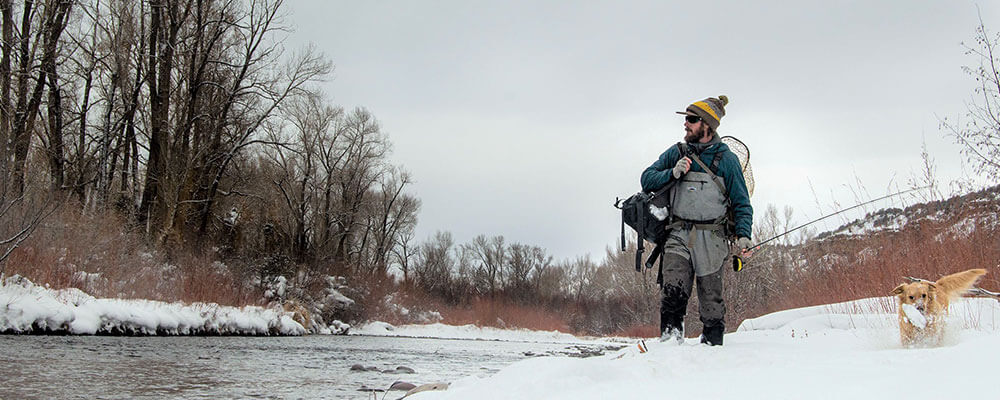
I absolutely love winter. The solitude provided this time of year is second to none, especially on trout waters that are becoming more popular in other seasons. Simply put, a lot of anglers are not willing to layer up and get into the water when the mercury hangs on the lower end of the thermometer. I get it. Trout fishing the months of December through February in Colorado is a far cry from wet wading in July. Icy cold fingers, frozen guides, cold feet and post-fishing tailgate beers that can freeze solid present different circumstances that must be addressed to maximize your enjoyment. Paying special attention to your apparel and equipment will boost your comfort level in the dead of winter and allow you to focus on the specific techniques and strategies needed to get the most out of this overlooked season on the river.
Your apparel becomes critical when conditions are working against you. In winter, the adverse is the everyday and extra care should be given to what you wear. The four things I focus on are my core, head, hands and feet.
Core
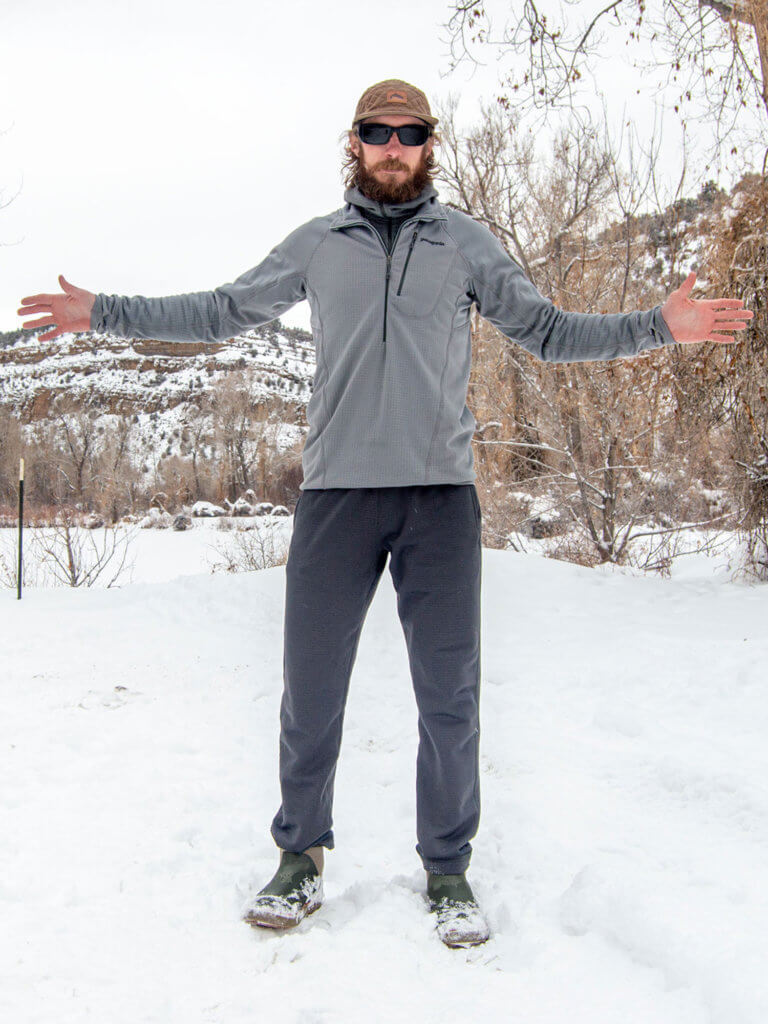 The foundation of your kit begins with a solid layering system. To keep your core warm and help you concentrate on the fishing, I start with a good set of synthetic or wool long underwear, top and bottom. I want my base layers to be warm and focus on wicking sweat away from my body. These wicking layers not only keep your skin dry, they boost the effectiveness of your additional layers. On top of the base layers, I always add a mid-layer top of grid fleece, merino wool or a lightweight breathable synthetic insulation piece. On top of this layer, I almost always add a lightweight synthetic vest. This crucial piece of gear locks in core warmth and works wonders to keep your extremities functioning in the cold. For my lower body, I either wear a pair of grid fleece pants over my base layer, a pair of synthetic insulated puffy pants or both when it is absolutely brick outside. My outermost layer for the upper body is an insulated jacket, synthetic or down, that goes over the rest and still allows me to move. It goes without saying that I’m wearing waders at this time of year. My winter set is roomier than what I wear in the spring and fall to accommodate the extra layers without compressing them too much or restricting mobility. If it is snowing, I will use a lighter weight puffy and shell jacket to keep the snow on the outside and seal in my heat from the precipitation and wind. I find that a windy day in winter is much colder than a snowy day. Lastly, I like to wear my chest waders over the top of all my upper body layers unless I have the shell jacket on. In this case, my jacket goes over the top of my chest waders.
The foundation of your kit begins with a solid layering system. To keep your core warm and help you concentrate on the fishing, I start with a good set of synthetic or wool long underwear, top and bottom. I want my base layers to be warm and focus on wicking sweat away from my body. These wicking layers not only keep your skin dry, they boost the effectiveness of your additional layers. On top of the base layers, I always add a mid-layer top of grid fleece, merino wool or a lightweight breathable synthetic insulation piece. On top of this layer, I almost always add a lightweight synthetic vest. This crucial piece of gear locks in core warmth and works wonders to keep your extremities functioning in the cold. For my lower body, I either wear a pair of grid fleece pants over my base layer, a pair of synthetic insulated puffy pants or both when it is absolutely brick outside. My outermost layer for the upper body is an insulated jacket, synthetic or down, that goes over the rest and still allows me to move. It goes without saying that I’m wearing waders at this time of year. My winter set is roomier than what I wear in the spring and fall to accommodate the extra layers without compressing them too much or restricting mobility. If it is snowing, I will use a lighter weight puffy and shell jacket to keep the snow on the outside and seal in my heat from the precipitation and wind. I find that a windy day in winter is much colder than a snowy day. Lastly, I like to wear my chest waders over the top of all my upper body layers unless I have the shell jacket on. In this case, my jacket goes over the top of my chest waders.
Head
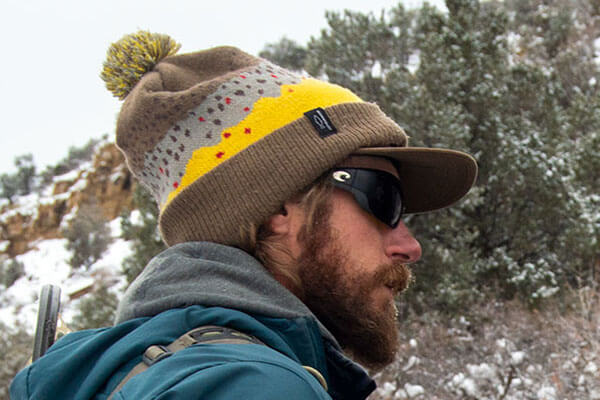 Consider how many hoods you have in your layering system. I have caught myself wearing 5 hooded pieces and this tends to get in your way more than it helps. I prefer a hood on either a base layer or mid layer, but not both and a hood on my final layer, whether that is a down puffy or my waterproof fishing shell. A base layer hood underneath a winter hat will also keep your neck warm and really boost the heat-holding potential of your kit. Make sure that your hoods, winter hat and sunglasses fit together comfortably. I prefer to wear some sort of hat with a bill. Whether that is a waterproof fleece lined hat with a bill and ear flaps or a beanie over a ball cap, ensure that your hat fits comfortably with your sunglasses.
Consider how many hoods you have in your layering system. I have caught myself wearing 5 hooded pieces and this tends to get in your way more than it helps. I prefer a hood on either a base layer or mid layer, but not both and a hood on my final layer, whether that is a down puffy or my waterproof fishing shell. A base layer hood underneath a winter hat will also keep your neck warm and really boost the heat-holding potential of your kit. Make sure that your hoods, winter hat and sunglasses fit together comfortably. I prefer to wear some sort of hat with a bill. Whether that is a waterproof fleece lined hat with a bill and ear flaps or a beanie over a ball cap, ensure that your hat fits comfortably with your sunglasses.
Hands
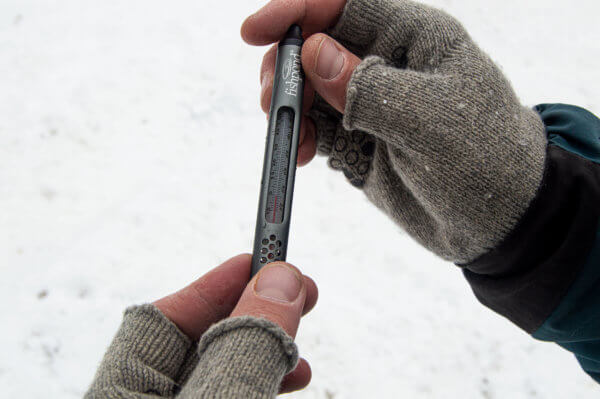 The hands are typically the deal breaker for most anglers looking to extend their fishing season. Gloves are a challenge where dexterity is essential, especially when you are using 6X and #24s. I like a fingerless glove, but not just any glove. I have owned no less than a dozen pairs of these style gloves over the years and have cussed them more than praised them. My favorite are plain old wool fingerless gloves with a rolled finger. Most fleece or Windstopper type gloves have a snug fit around the fingers. I have found that these inhibit circulation and actually work against me. The wool fingerless gloves are knitted and the fingers are rolled at the ends where the stitching stops. I am amazed at how warm these gloves keep my hands. Being fingerless, I can tie knots and feel my line while fishing. The wool also does a surprisingly good job of retaining its warmth when it gets wet.
The hands are typically the deal breaker for most anglers looking to extend their fishing season. Gloves are a challenge where dexterity is essential, especially when you are using 6X and #24s. I like a fingerless glove, but not just any glove. I have owned no less than a dozen pairs of these style gloves over the years and have cussed them more than praised them. My favorite are plain old wool fingerless gloves with a rolled finger. Most fleece or Windstopper type gloves have a snug fit around the fingers. I have found that these inhibit circulation and actually work against me. The wool fingerless gloves are knitted and the fingers are rolled at the ends where the stitching stops. I am amazed at how warm these gloves keep my hands. Being fingerless, I can tie knots and feel my line while fishing. The wool also does a surprisingly good job of retaining its warmth when it gets wet.
I also carry a pair fingerless gloves with a foldover-style mitten attached at the back. Lots of companies make these. Try them on and see what you like. Pay attention to how the foldover sections tuck away. Will they catch line? Are they easy on and off? Lastly, how do they work with the rest of your outerwear? I keep these in my waders and use them to warm up if my hands get too cold or I’m heckling my buddies from the bank. Alternatively, a pair of warm ski gloves or mittens are a really nice thing to have in a gear bag on the bank with lunch. I do not fish in these but having a guaranteed warm place for your hands to dry out is a wonderful luxury.
Pro tip: Minimize handling a fish in winter. Removing a fish from 33 degree water and holding it out of the river can kill a fish in the winter. Pinch your barbs, use a rubber bag landing net and an easy-out hook removal tool. This also keeps your hands drier and warmer. If you catch one worthy of a photo, make a plan with your buddy while the fish is in the net, keep ‘em wet and work quickly to minimize harm.
Feet
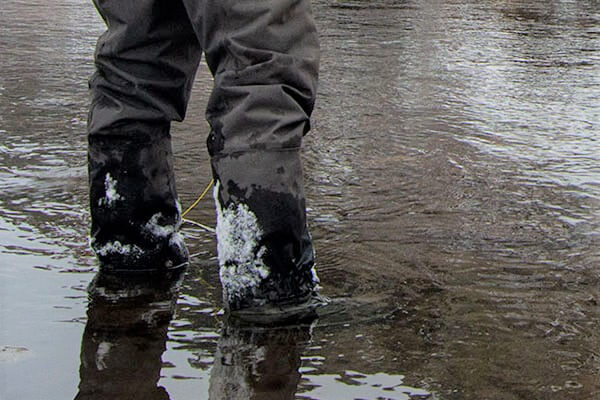 Cold feet are the easiest obstacle to overcome for the winter trout angler. I know this seems counterintuitive—you are standing in the water after all—but keep in mind the water is often warmer than the air in winter. Years of selling waders and wading boots have taught me that proper fit is paramount. For winter fishing, you want your gear to be a little roomier. If your boots or neoprene socks are too tight you lose circulation, guaranteeing cold feet. A common misconception is to add a heavier pair of socks or wear two pairs of socks. If your wader fit is already off, the heavier socks will make your feet colder because your insulation in now compacted and your circulation inhibited. A single pair of quality mid-weight wool socks will keep your feet warmer than cramming a heavyweight pair of thermal socks into your boots. Think about your ski boots. I wear pantyhose-thin socks in my ski boots and let my boot liners do their job, even when it is below zero on the chairlift. The same principle applies to wading boots. Neoprene booties are very warm when they are properly fitted and paired with the correct socks for the conditions. I wear either a single pair of over-the-calf thermal weight wool socks or a thin liner sock and a mid-weight pair of over-the-calf wool socks. Both setups are toasty as long as you can wiggle your toes.
Cold feet are the easiest obstacle to overcome for the winter trout angler. I know this seems counterintuitive—you are standing in the water after all—but keep in mind the water is often warmer than the air in winter. Years of selling waders and wading boots have taught me that proper fit is paramount. For winter fishing, you want your gear to be a little roomier. If your boots or neoprene socks are too tight you lose circulation, guaranteeing cold feet. A common misconception is to add a heavier pair of socks or wear two pairs of socks. If your wader fit is already off, the heavier socks will make your feet colder because your insulation in now compacted and your circulation inhibited. A single pair of quality mid-weight wool socks will keep your feet warmer than cramming a heavyweight pair of thermal socks into your boots. Think about your ski boots. I wear pantyhose-thin socks in my ski boots and let my boot liners do their job, even when it is below zero on the chairlift. The same principle applies to wading boots. Neoprene booties are very warm when they are properly fitted and paired with the correct socks for the conditions. I wear either a single pair of over-the-calf thermal weight wool socks or a thin liner sock and a mid-weight pair of over-the-calf wool socks. Both setups are toasty as long as you can wiggle your toes.
Pro tip 1: If you are serious about winter fishing, consider purchasing a pair of winter wading boots that are a size up. Pro tip 2: pay attention to your feet and when they start to get tingly or numb, hop out of the river and take a break. Have a snack, take a nip of grandpa’s cough medicine or some coffee or tea from a thermos. Clean up your flies or change them and get ready for another session.
The Fishing Part
You are snug as a bug in a rug, all layered up and ready to fish. Now what? The first part of the puzzle is finding productive water. In SW CO, these are generally tailwaters. Wintertime brings less pressure, lower flows and gin clear water to these famous stretches of western water.
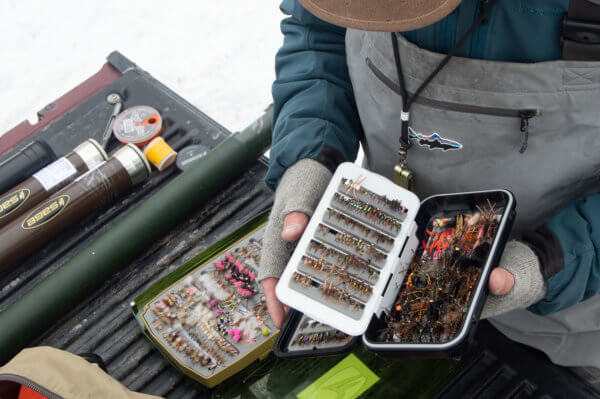 Nymphing with midges is the normal operating method, but do not overlook the possibility of a midge hatch. I have had some all-time days throwing dry flies in sub-freezing conditions. Best to keep the box of midge dries in your bag. Light tippet is almost a rule and 6X fluorocarbon is essential in my opinion. Keep your rig manageable. This is not the time to fish a team of 5 flies. Maintaining your rig, changing flies and adjusting weight and depth are as important in the winter as they are in the summer. Keep efficiency in mind and focus on perfecting your drift. Lower flows and clear water can offer some excellent sight nymphing opportunities. I have found that the right drift will catch more fish than the right fly when trout are not willing to move far in cold temperatures.
Nymphing with midges is the normal operating method, but do not overlook the possibility of a midge hatch. I have had some all-time days throwing dry flies in sub-freezing conditions. Best to keep the box of midge dries in your bag. Light tippet is almost a rule and 6X fluorocarbon is essential in my opinion. Keep your rig manageable. This is not the time to fish a team of 5 flies. Maintaining your rig, changing flies and adjusting weight and depth are as important in the winter as they are in the summer. Keep efficiency in mind and focus on perfecting your drift. Lower flows and clear water can offer some excellent sight nymphing opportunities. I have found that the right drift will catch more fish than the right fly when trout are not willing to move far in cold temperatures.
Frozen guides are a frustrating inevitability when the temps are below 25 degrees. Ice-off paste on the rod guides will help but will not wholly eliminate it. I generally clear off the ice when it starts to weigh the rod down and try to do this before the line actually freezes to the guides. This is also great time to take a break, re-rig and re-assess. Maybe you only get 20 minutes to fish between ice breaking. Make a plan, fish your 20 minutes, break ice then re-group. Fish slow and steady just like the fish are eating, slow and steady.
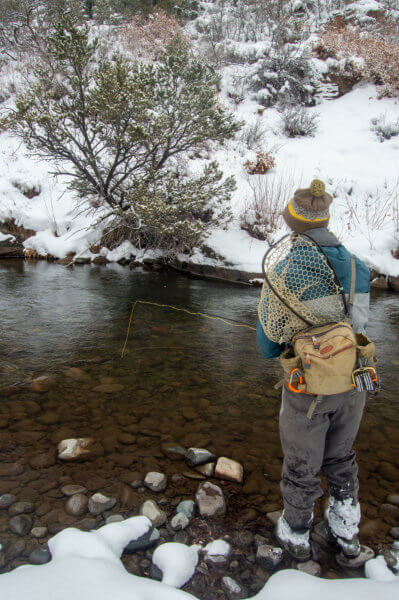 Winter conditions force trout into specific holding water. Unlike summer where holding water centers around food and oxygen availability, winter holding water is influenced primarily by water temperature and speed. A positive change of a degree or two makes a huge difference in the fish’s metabolic reaction to a fly and in the number of fish in a particular section of a run. Start your day focusing on slower, deeper water. These runs harbor fish throughout the winter. Long, slow drifts with flies fished deep will produce takes. Remember, the fish are not going to move a great deal to pick up a midge. Takes will be subtle.
Winter conditions force trout into specific holding water. Unlike summer where holding water centers around food and oxygen availability, winter holding water is influenced primarily by water temperature and speed. A positive change of a degree or two makes a huge difference in the fish’s metabolic reaction to a fly and in the number of fish in a particular section of a run. Start your day focusing on slower, deeper water. These runs harbor fish throughout the winter. Long, slow drifts with flies fished deep will produce takes. Remember, the fish are not going to move a great deal to pick up a midge. Takes will be subtle.
A streamer is an excellent way to cover this type of water as well. I like to fish a streamer slow and steady with a jiggy action. Bring the fly up in the water column, let it sink and repeat. Floating lines work well for this technique and increase the rise and fall of the fly. Alternatively, a streamer may be fished under an indicator, maintaining a specific depth. Pay special attention to the end of the drift as the fly rises up in the water column. Sinking lines are excellent in very deep water and help to keep the streamer down low in the strike zone through the retrieve. When fishing sinking lines in the winter, try to find the bottom with the fly. Remember your cast, position in the river and the amount of time you allowed the fly to sink. Work out these variables until you have that fly swimming just off the bottom without getting hung up.
Stay patient, fish carefully and pay attention to clues offered by the river. As the day warms, you may notice adult midges beginning to hatch and with any luck, trout keying on them. Shallow sections of the river that were fringed with ice in the morning may now hold trout looking for an easy meal on the surface. Shallow water warms more quickly than deep water and can evolve into a prime feeding lie during warm periods. These events are short lived during winter. Once the sun leaves the water, the fish will slide back into the depths. Generally, the fishing improves in winter with an increase in temperature. Keep in mind that the increase in water temperature is the trigger and the water will take a little longer to warm up than the air.
While rods do not suffer in the cold, a reel can. I like sealed drag reels with smooth operating handles made of a synthetic material and I try to keep the reel out of the snow and water. Dunk that reel and watch how quickly everything can freeze up. Aluminum gets very cold and a metal handle can be a real pain with wet fingers.
Float Fishing
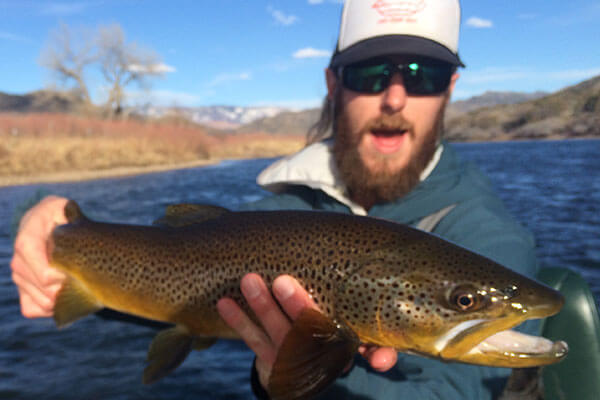
I absolutely love to be in the boat throughout the year. I am a river rat at heart. It takes a lot to convince me we ought to be doing something other than floating. My winter layering kit is about the same for the boat with one big exception. I usually do not wear waders this time of year. Instead, I choose waterproof bibs and Muck boots. I only wear this kit if I am not getting out of the boat to wade. The knee-high boots give me enough clearance from the water to load and unload the boat and I find this set of gear to be warmer and more comfortable than my waders. This system is easier to add or remove layers, easier to answer the call of nature and just more comfortable for moving around the boat. Think about duck hunting in a layout blind. Also, I always bring a waterproof dry bag with extra puffy jackets, warm gloves and winter hats.
Pro tip: bring some soup in a thermos to supplement lunch. A good friend and fellow guide once told me, “You cannot control the fishing, but you can always control lunch.” Miso soup makes for easy drinking and clean up without the need for a spoon.
Finally, I have never heard a fishing buddy or client complain about the cold when we’re catching fish. Layer up properly with good gear and go out there and have some fun!
My Winter Gear
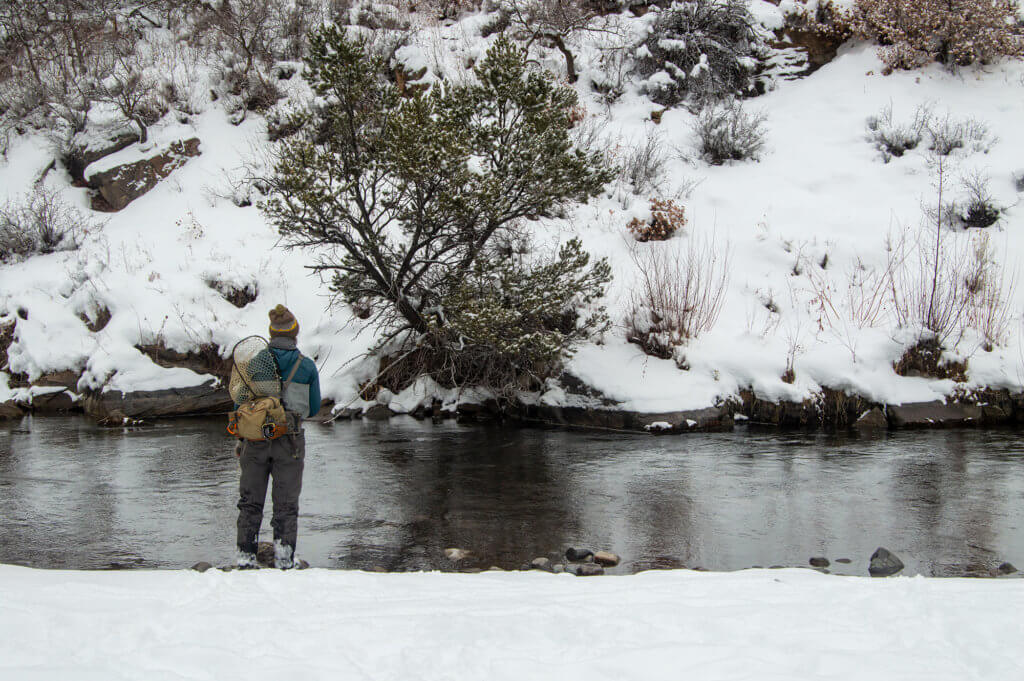 Patagonia Swiftcurrent Expedition Waders
Patagonia Swiftcurrent Expedition Waders
Patagonia X Danner Foot Tractor Wading boots with Vibram sole
Patagonia Tough Puff Jacket
Patagonia Thermal Weight baselayers
Patagonia R1 Pant and top for mid layers
Patagonia Nano Puff Pants
Patagonia Nano Puff Vest
Simms Westfork Jacket
Simms Exstream Jacket
Simms OTC Thermal or Midweight Wading socks
Simms Wool Half Finger gloves
Simms Gore-Tex Exstream Foldover Mitts
Simms Gore-Tex Exstream Cap
Great article, thanks! Just good to know in general how to stay warm out there, the gloves and socks gear are surprisingly low-tech.
Good stuff. Especially the soup. Two suggestions to add:
1. Nitrile gloves can make a big difference in keeping hands warm and will fit well under properly-sized fingerless gloves. You will especially appreciate them if/when you have to get your fingers wet.
2. Pre-rigging 6-10 set-ups with your favorite flies and storing them wound around a foam block can save a ton of time and frustration when fingers are cold. 18” of 3x on top makes tying into the fly line with a clinch knot easy, even with nitrile gloves on. You won’t miss tying on tiny flies on frigid days.
Matt,
Thanks for your input for our article. These are excellent, practical suggestions. Where do you live and fish?